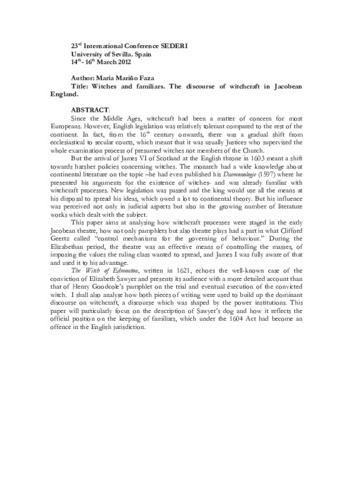Witches and Familiars. The discourse of witchcraft in Jacobean England
Author:
Subject:
witchcraft
English drama
cultural studies
new historicism
demonological tract
James I
Publication date:
Abstract:
Since the Middle Ages, witchcraft had been a matter of concern for most Europeans. However, English legislation was relatively tolerant compared to the rest of the continent. In fact, from the 16th century onwards, there was a gradual shift from ecclesiastical to secular courts, which meant that it was usually Justices who supervised the whole examination process of presumed witches not members of the Church. But the arrival of James VI of Scotland at the English throne in 1603 meant a shift towards harsher policies concerning witches. The monarch had a wide knowledge about continental literature on the topic –he had even published his Daemonologie (1597) where he presented his arguments for the existence of witches- and was already familiar with witchcraft processes. New legislation was passed and the king would use all the means at his disposal to spread his ideas, which owed a lot to continental theory. But his influence was perceived not only in judicial aspects but also in the growing number of literature works which dealt with the subject. This paper aims at analysing how witchcraft processes were staged in the early Jacobean theatre, how not only pamphlets but also theatre plays had a part in what Clifford Geertz called “control mechanisms for the governing of behaviour.” During the Elizabethan period, the theatre was an effective means of controlling the masses, of imposing the values the ruling class wanted to spread, and James I was fully aware of that and used it to his advantage. The Witch of Edmonton, written in 1621, echoes the well-known case of the conviction of Elizabeth Sawyer and presents its audience with a more detailed account than that of Henry Goodcole’s pamphlet on the trial and eventual execution of the convicted witch. I shall also analyse how both pieces of writing were used to build up the dominant discourse on witchcraft, a discourse which was shaped by the power institutions. This paper will particularly focus on the description of Sawyer’s dog and how it reflects the official position on the keeping of familiars, which under the 1604 Act had become an offence in the English jurisdiction.
Since the Middle Ages, witchcraft had been a matter of concern for most Europeans. However, English legislation was relatively tolerant compared to the rest of the continent. In fact, from the 16th century onwards, there was a gradual shift from ecclesiastical to secular courts, which meant that it was usually Justices who supervised the whole examination process of presumed witches not members of the Church. But the arrival of James VI of Scotland at the English throne in 1603 meant a shift towards harsher policies concerning witches. The monarch had a wide knowledge about continental literature on the topic –he had even published his Daemonologie (1597) where he presented his arguments for the existence of witches- and was already familiar with witchcraft processes. New legislation was passed and the king would use all the means at his disposal to spread his ideas, which owed a lot to continental theory. But his influence was perceived not only in judicial aspects but also in the growing number of literature works which dealt with the subject. This paper aims at analysing how witchcraft processes were staged in the early Jacobean theatre, how not only pamphlets but also theatre plays had a part in what Clifford Geertz called “control mechanisms for the governing of behaviour.” During the Elizabethan period, the theatre was an effective means of controlling the masses, of imposing the values the ruling class wanted to spread, and James I was fully aware of that and used it to his advantage. The Witch of Edmonton, written in 1621, echoes the well-known case of the conviction of Elizabeth Sawyer and presents its audience with a more detailed account than that of Henry Goodcole’s pamphlet on the trial and eventual execution of the convicted witch. I shall also analyse how both pieces of writing were used to build up the dominant discourse on witchcraft, a discourse which was shaped by the power institutions. This paper will particularly focus on the description of Sawyer’s dog and how it reflects the official position on the keeping of familiars, which under the 1604 Act had become an offence in the English jurisdiction.
Description:
International Conference SEDERI (23. 2012. Sevilla)
Collections
Files in this item





